No-one would label a business jet a mass-market consumer item, yet recent developments show they share a common trend. While some may rave about right-sizing and sustainability, consumers continue to demand larger and more spacious products.
The midsize business jet segment in particular is undergoing such an expansion. Embraer staked out the high ground with its Legacy 450, a smaller variant of its 500 model. The Brazilian duo share a common fuselage cross section that offers a stand-up cabin with a flat floor. Bombardier joined the fray with the 1.80m-high cabin Learjet 85 – a programme now on hold.
Cessna too saw an opportunity for a larger cabin offering in the midsize segment. However, while Embraer and Bombardier sought to field clean sheet designs, Cessna chose to build upon its past successes to fill this promising niche.
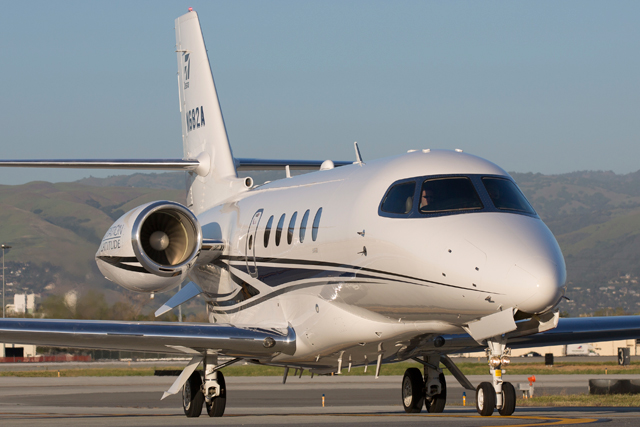
Jeremy Dwyer-Lindgren
Model 680
In 2004 Cessna certificated its Model 680 Sovereign, a transcontinental super-midsize Citation, which I had the pleasure of flying. Changing market demands and technological advances over the next 10 years then convinced Cessna to offer the Sovereign+. More than a freshened-up Sovereign, it featured a Garmin 5000-derived Intrinsic flightdeck and advanced winglets.
The refined wing and other improvements increased the Sovereign+’s range by 150nm to 3,190nm (5,900km).
Later, to fill the midsize stand-up cabin segment, Cessna launched the Latitude in 2011. For the Latitude Cessna developed a new cockpit and passenger cabin while incorporating the wing and empennage/aft fuselage of the Sovereign+. The flightdeck is based on Garmin 5000 avionics and incorporates autothrottles.
While the Sovereign+ and Latitude share a common pilot type rating, it is the Latitude’s passenger cabin that brings something new to the market. With a flat floor and an over-aisle height of 1.83m, the Latitude cabin has the largest cross section of any Citation. While the Sovereign’s is about 1m longer, the Latitude’s cabin feels more spacious.
Passenger Improvements
Improvements to the passenger experience start with the cabin entry door. The 1.65m-high door is electrically actuated and retracts into a frame machined from a single piece of aluminium. Six steps and an integral handrail ease entry to the spacious cabin.
Cessna offers two basic configurations for the cabin. Both feature a club forward arrangement with two forward-facing seats aft. The six main pedestal seats can swivel 180˚ but can be berthed. Forward, opposite the entry door, customers can select either a standard two-place or optional single-place side-facing seat. In the optional configuration the extra seat is replaced by a storage cabinet. Fully aft, the lavatory has an externally serviced commode with a plug-type emergency exit window behind it. Opposite the commode is a belted seat, certificated for occupancy during take-off and landing.
The Latitude’s well appointed cabin is the most spacious ever offered in a Citation. It is 0.27m wider and 0.10m taller than the Sovereign’s. Ten windows allow ambient light to stream into the main cabin – these windows are fully 25% larger than those found on the Sovereign+, further accentuating the cabin’s spacious feel.
Meanwhile, those passengers not enticed to enjoy the view will not be disappointed by the onboard entertainment options. The wireless Clarity cabin management system (CMS) allows passengers to bring their own iPad or entertainment device. The CMS web application can be loaded automatically from the aircraft, and allows individual control of lighting and media content. Media content can also be pushed from one device to others over the cabin network. Finally, cabin temperature control can be delegated aft, where either galley-mounted switches or the CMS application can set the perfect temperature.
G5000 flightdeck
Like the Citation X+ I recently flew, the Latitude has a Garmin G5000-based avionics suite. Three 14in (diagonal) Garmin wide-format displays dominate the instrument panel. Four Garmin GTC570 high-definition control and display units (CDU) are strategically placed in the cockpit. The CDUs use infrared positioning to locate button actuations, not screen deflection. The outboard units are used to control each pilot’s respective primary flight display (PFD), while the two pedestal-mounted units are used to interface with the centre-mounted multifunction display (MFD) and flight management system (FMS). To navigate around a selected display there is a cursor control stick on the bottom bezel of each unit. One neat CDU feature is the ability to use its face as a track pad. The flight guidance panel, to control the autopilot and flight director FD, is mounted on the centre of the glare shield. A single gauge electronic standby flight display, with an internal backup battery, is mounted between the flight guidance panel and MFD. As with the X+, there is also a small overhead panel to control lighting.
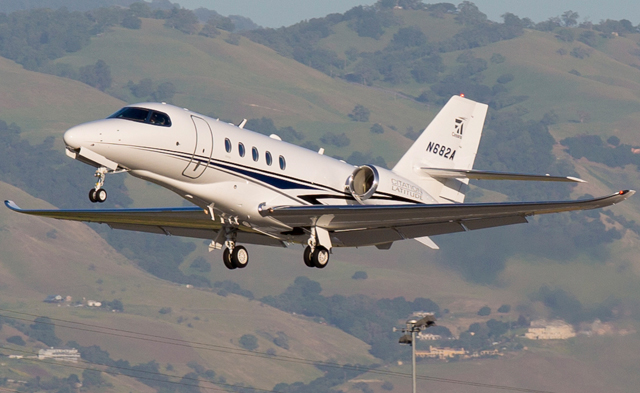
Jeremy Dwyer-Lindgren
Inflight evaluation
Flight International was recently invited to fly Cessna’s stand-up cabin Latitude out of Mineta San Jose International airport (KSJC). I followed Aaron Tobias, Latitude chief test pilot, as he accomplished the preflight walk-around inspection of preview aircraft N682A. It was production representative, with a full production passenger interior. The bsasic empty weight of the aircraft was about 90kg (198lb) heavier than standard due to some flight test kit installed on this, the second airframe built. Perhaps the most striking aspect of the Latitude was its relatively long, high aspect ratio wing (9.65). The upturned winglets were pleasing to the eye and had demonstrated real world performance gains for the Sovereign+. The finish of the enlarged fuselage was another thing that caught my eye. While constructed primarily of aluminium, the extensive use of adhesive bonding in manufacturing yielded a smooth surface – one on par with that of the composite Hawker 4000 I had flown several years ago. While the Latitude does use the wing and empennage of the Sovereign+, it looks like a unified design. The only hint that it was not a clean sheet design was the two aft fuselage-mounted ventral fins. They were not installed to augment stability like those of a Learjet; rather they were installed to reduce loading on the vertical fin.
Prior to entering the flightdeck, Textron Aviation test pilot Dustin Smisor showed me around the passenger cabin. I found the cabin was quite an improvement over other Citations I had flown. The integral shades in the large main cabin windows were all raised, accentuating the large volume of space available to those fortunate to ride in the Latitude.
Once strapped into the left seat I adjusted my position by reference to the eye alignment balls on the windscreen’s centre pillar. The thrust levers fell readily to hand, but as with other Citations I found the yoke a tad too high for my liking. Like the G5000 flightdeck on the X+, I found the Latitude’s to be thoughtfully arranged. The three large liquid crystal displays provided plenty of real estate to display flight-critical information.
As with other G5000 flightdecks, one can be overwhelmed by seemingly endless options. I was glad Tobias was there to guide me through initialisation and pre-start procedures. The tail-mounted auxiliary power unit (APU) was started to provide cooling air prior to engine start. While a battery-only start is possible, both engines were stared using electrical power from the APU. As each engine’s generator came online, the electrical system automatically reconfigured itself. Prior to releasing the parking brake the flaps were set to “2” (15˚ extension) in preparation for take-off.
Powered nosewheel steering
Due to gusty wind conditions, Tobias suggested we lock the flight controls for our taxi to runway 30 Left for take-off. During the short taxi I used the side console-mounted hand wheel to negotiate 90˚ turns. Rudder pedal displacement alone provided enough authority to track straight portions of the taxiways. Along the way we checked the thrust reverses and the functionality of the rudder bias system. Prior to taking the runway we unlocked the flight controls. Had we forgotten to unlock them, the left thrust lever would have been stopped half way up the quadrant. Additionally, we would have gotten a central alert and aural “no take-off” messages.
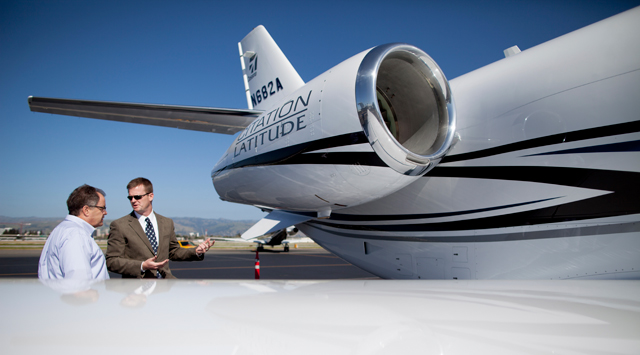
Jeremy Dwyer-Lindgren
Aligned on the runway I armed the autothrottles with the thrust lever-mounted switch. Once cleared for take-off, advancing the thrust levers about midway up the quadrant caused the autothrottle clutch to engage. The autothrottle mechanism then moved the thrust levers and set take-off power. Published field length for the 11,181kg (three occupants and 2,522kg fuel) aircraft was only 884m (2,900ft), and it leapt off the runway after a ground run of approximately 800m. Pitch force changes during clean up and acceleration were small, and easily countered with the electric stabiliser trim. As we were below the San Francisco tower's Class B airspace, we held 200KIAS until we climbed into it at 8,000ft, after which we accelerated to 250kt (463km/h) indicated airspeed. Passing 10,000ft I engaged the autopilot for the climb to altitude. Passing FL290 we switched to Mach number speeds, and M0.64 was held until levelling off at FL430. Time from brake release to level off was about 19min, with a fuel burn of 386kg (850lb). Test day observed climb performance compared favourably to book numbers of 17min and 354kg, with airspace-related airspeed restrictions and numerous air traffic control-directed turns accounting for the differences.
Cruise speed
During the climb the autothrottle had automatically set climb power, and once level it held maximum continuous thrust for 10min. After the aircraft had stopped accelerating I set 98% N1, cruise power. At near standard day conditions 1,460lb per hour (pph) fuel flow held an indicated airspeed of 215kt. Indicated Mach was 0.768, with a resultant true airspeed of 440kt. Next I slowed the Latitude to M0.74, to simulate a long-range cruise condition. Total fuel flow dropped to 1,400pph and true airspeed decreased to 423kt. The near linear relation between fuel flow and speed indicates that there is little benefit in slowing the Latitude down at this altitude. On the flightdeck I noted a cabin altitude of only 5,500ft, with Cessna listing a cabin altitude of 5,950ft at its 45,000ft ceiling. The Latitude’s 0.7bar (10psi) pressurisation system provides a lower cabin altitude than any other Citation product. Cabin deck angle was less than 2˚, which should allow for easy transit of the large cabin. While Cessna provided no acoustic data, my brief exposure to it at altitude showed the Latitude’s cabin to be a quiet one.
Safety features
As with several other Citation products, the Latitude’s autopilot has an emergency descent mode. At altitudes above 30,000ft, should cabin altitude exceed 14,500ft, the autopilot will turn the aircraft 90˚ to the left and initiate a descent. The autothrottles will also wake up, if not engaged, and pull power to idle to speed the descent. Without further pilot intervention the aircraft will level at 15,000ft. To simulate an actual “high dive” I retarded the thrust levers to idle and started a descent to 14,500ft, where some medium altitude manoeuvres would be accomplished. During the descent I allowed the aircraft to accelerate to M0.80. Stable there, I did a series of small sharp control inputs in each axis. Aircraft response was well damped in all cases. Next I lowered the nose slightly and advanced the thrust levers, accelerating the Latitude to M0.806. At that speed the autothrottles woke up and retarded power towards idle in an effort to stop the overspeed. Had the autopilot been engaged, it would have raised the nose to slow the aircraft.
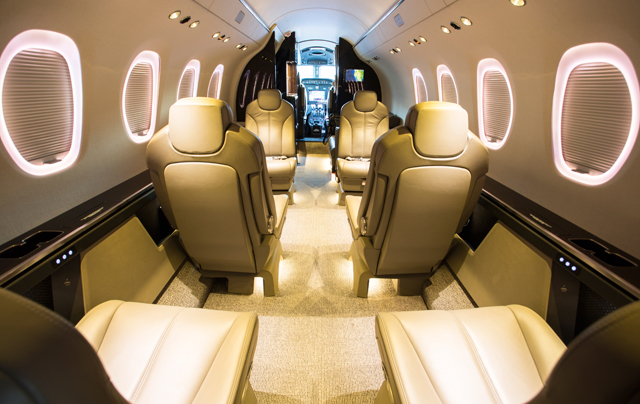
Jeremy Dwyer-Lindgren
Next, an idle power descent was re-established and the speed brakes fully extended. At speeds approaching maximum operating speed (VMO, 305kt IAS), less than 4kg of forward yoke pressure was needed to counter the pitch up motion caused by extending the speed brakes. Passing 19,000ft flight level at 280kt, the Latitude was descending at a rate in excess of 10,000ft/min – quite a handy capability to have in case of an actual depressurisation. Once level at 14,500ft I retracted the speed brakes and allowed the Latitude to slow to 250kt. Once stable there I did a several 45˚ turns. The primary display's flightpath maker helped me maintain level flight, while the speed trend arrow eased airspeed control. Pitch control forces were moderate, while those in roll were well on the heavy side. I did note that the yaw damper was quite effective, allowing the manoeuvres to be performed with my feet on the floor, and off the rudder pedals.
Aft stick stall
Established in the medium altitude regime, I further slowed the Latitude to investigate its low speed handling qualities. For the first event, Tobias suggested we see how the autothrottles’ wake-up feature would prevent us slowing to an unsafe speed. While maintaining level flight in a clean configuration, idle power slowed the Latitude at about 1kt/s. While the primary flight display's pitch limit indicator and airspeed tape clearly showed we were too slow, I continued to hold aft yoke pressure. Sensing the slow speed condition, the autothrottles woke up at 107kt and advanced the thrust levers. While the speed decreased to 105kt, the stick shaker didn’t activate. Once a speed of 107KIAS was attained, the autothrottles returned to their inactive state.
To see how the Latitude performed in a stalled state, Tobias disabled the autothrottles by pulling the circuit breaker. The first stall was in a clean configuration. While slowing at about 1kt/s with idle power, the stick shaker activated at 104kt. Continued aft yoke pressure slowed the Latitude further. A slight wing rock developed as we slowed through 95kt. Using rudder alone I tried to keep the wings level. My pedal inputs were too large, however, exacerbating the rocking and causing a sizable wing drop at 91kt. Forward yoke pressure and advancing the thrust levers to mid-range recovered the Latitude to normal flight conditions. Prior to setting a landing configuration stall – gear down and flaps full – Tobias recommended I use ailerons alone to control any wing rock. In idle power the fully configured Latitude slowed until the shaker activated at 81kt. Continued aft yoke pressure slowed the aircraft further, and a small wing rock developed. This time I only used small aileron inputs to level the wings. During the preflight walk-around I had noticed seven small vortex generators on the wings’ leading edge, directly forward of the ailerons. At 75kt the ailerons were extremely effective allowing me to keep the wings level in a full aft yoke stall. Pleased with its control at slow speed, I lowered the nose and advanced the power to recover the Latitude to normal flight conditions.
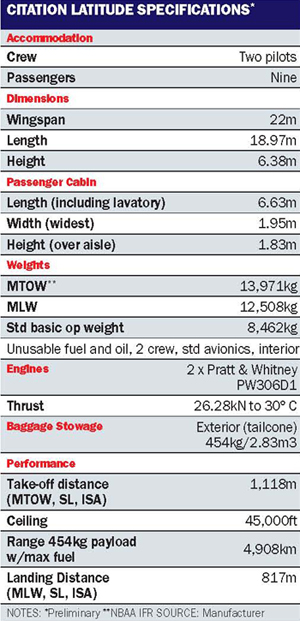
With the slow speed manoeuvres complete, the gear and flaps were retracted for return to San Jose. Recovery to KSJC was via radar vectors to an instrument landing system (ILS) final approach segment to runway 30L. After capturing the localiser I disconnected the autopilot and autothrottle and hand-flew the aircraft to get a better feel for the Latitude. Pitch force changes during configuration were small and easily handled by stabiliser trim. Flap movement from 2 (15˚) to full (35˚) caused a large pitch change, but this is transparent to the pilot as automatic pitch trim compensation masks it. At a gross weight of 10,200kg, about 50% N1 on each engine was needed to hold the target speed of 106kt. As per the flight manual, the yaw damper was disengaged for the approach, and despite gusty wind conditions the Latitude was rock steady as I tracked the localiser and glide slope. At 50ft radar altitude I retarded the thrust levers to idle. My initial round out was a few feet higher than optimal, but I milked it down to the runway, where the trailing link main landing gear ensured a smooth touchdown. The speed brakes were manually extended and wheel brakes alone used to slow to a safe taxi speed.
Feet on floor V1 cut
After the full stop landing we taxied back to the approach end of runway 30L for what I thought was to be a simulated engine failure after lift-off (V2 cut) and one engine inoperative approach. Accelerating down the runway, Tobias, to my surprise, pulled the right thrust lever to idle as we approached 98kt/V1, simulating an engine failure. I have lost count of the number of V1 cuts I have done in the simulator, but the number I have done in a real aircraft can be counted on two hands. My first impulse was to immediately put in left rudder, but the Latitude tracked straight down the centerline with no action on my part. Tobias called “rotate” at 102kt, and as I pulled aft on the yoke I anticipated the need for some left rudder, but none was needed. Only after we accelerated past the initial climb speed of 125kt was any rudder input needed to maintain co-ordinated flight with one engine inoperative. Cessna had put an incredible amount of time and effort into fine-tuning the Latitude’s rudder bias system. Keyed by differential engine bleed air pressure and current flight conditions, the rudder bias system had turned what can be a multiengine pilot’s worst fears into a yawning (not yawing) experience.
I flew a left hand visual circuit to runway 30L for the one engine inoperative approach. On final with gear down and flaps 2, our target speed was 110kt – only slightly higher than our full flapped normal approach speed had been. I tracked the ILS glideslope and, with rudder trim centred, only a slight amount of left rudder was needed to maintain co-ordinated flight on the localiser. I again retarded the power to idle at about 50ft radar altitude, this time for a better round out and on-speed touchdown. Tobias said we had time for one more circuit, so I advanced both engines to make this a roller. The final circuit was a visual one, with flaps full for the full stop. Target speed was again 106kt, and this time I aimed to touch down about 150m past the threshold. After a firm touchdown and speed brake extension, I applied enough pressure on the wheel brakes to cycle the anti-skid. Ground roll for the 9,930kg aircraft was less than 700m. In dry conditions Cessna takes no credit for thrust reverser usage, and our actual ground roll at San Jose lends credence to their published landing data over a 15m obstacle.
Stand-up guy
During the short taxi back to ramp I reflected on something the tower controller had said while we were working the visual circuit. He was puzzled that although we had a Model 680 equipment designation, we didn’t look like a Sovereign. Tobias replied that we had a larger diameter but shorter fuselage, with not as much range. The controller’s immediate comeback was that it sounded like we were slotted between the XLS and Sovereign. He had nailed it. With the Latitude Cessna has found a viable segment in its line-up that could be expanded and filled. The wide-bodied Latitude offers segment-leading take-off performance with no-wind transcontinental range for four. The Garmin 5000 flightdeck was as capable as any I had sampled in the midsized segment.
For now it looks like the Latitude’s only standing competition is the Legacy 450, and the consumer can only benefit from such spirited competition.
Source: Flight International



















